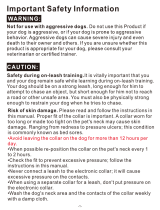
www.petsafe.net 15
Te r ms of Use and Limitation of Liability
1. Terms of Use
This Product is offered to you conditioned upon your acceptance without modifi cation of the
terms, conditions and notices contained herein. Usage of this product implies acceptance of all
such terms, conditions, and notices.
2. Proper Use
This Product is designed for use with pets where training is desired. The specifi c temperament of
your pet may not work with this product. We recommend that you not use this product if your pet
is less than 8 pounds or if your pet is aggressive. If you are unsure whether this is appropriate for
your pet, please consult your veterinarian, certifi ed trainer or contact our Customer Care Center
at (866) 381-2785.
Proper use includes reviewing the entire Operating and Training Guide provided with your
product and any specifi c Caution statements.
3. No Unlawful or Prohibited Use
This Product is designed for use with pets only. This pet training device is not intended to harm,
injure, or provoke. Using this product in a way that is not intended could result in violation of
Federal, State or local laws.
4. Limitation of Liability
In no event shall Radio Systems Corporation be liable for any direct, indirect, punitive, incidental,
special or consequential damages, or any damages whatsoever arising out of or connected with the
use or misuse of this Product. Buyer assumes all risks and liability from the use of this Product.
5. Modifi cation of Terms and Conditions
Radio Systems Corporation reserves the right to change the terms, conditions and notices under
which this Product is offered.
FCC
This equipment has been tested and found to comply with the limits for a Class B digital device,
pursuant to Part 15 of the FCC rules. Unauthorized changes or modifi cations to the equipment
that are not approved by Radio Systems Corporation are in violation of FCC regulations and
could void the user’s authority to operate the equipment and void the warranty.
FCC limits are designed to provide reasonable protection against harmful interference when the
equipment is operated in a residential environment. This equipment generates, uses, and can
radiate radio frequency energy. If not installed and used in accordance with the Operating and
Training Guide, the equipment may cause harmful interference to radio communications. There is
no guarantee that interference will not occur in a practical installation.




















